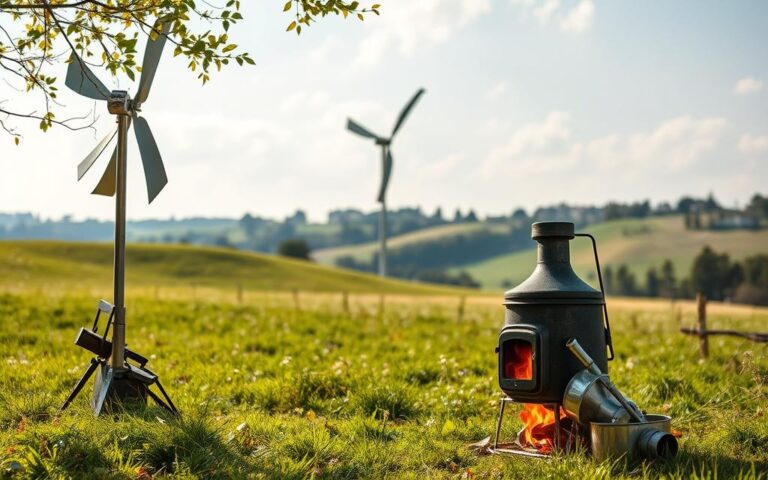A single inch of rainfall on a 1,000-square-foot roof can produce about 600 gallons of water. This fact shows the huge potential of rainwater harvesting as a renewable water source. It offers a smart way to live sustainably and manage resources.
Rainwater harvesting energy is a game-changer in water management and conservation. It helps communities rely less on regular water supplies. At the same time, it generates clean, sustainable energy for various uses.
This method does more than just collect water. It turns rain into a valuable resource for homes, farms, and industries. The technology works well in both cities and rural areas.
Rainwater harvesting offers a solution to water scarcity and environmental issues. It’s becoming crucial as climate change affects our water resources. By using these techniques, we can move towards a greener future.
Understanding Rainwater Harvesting Energy
Rainwater harvesting is an innovative way to generate sustainable power. It turns natural rainfall into a valuable energy resource. This method captures rainwater and converts it to electricity using advanced technology.
Rainwater energy systems use the natural water cycle to create power. They collect rainwater and direct it through hydroelectric micro-turbines. These turbines change water movement into electrical energy.

What is Rainwater Harvesting?
Rainwater harvesting collects rainfall from surfaces like rooftops and landscapes. It’s a strategic method to gather water for various uses.
- Collecting rainwater through specialized collection systems
- Storing water in designated reservoirs
- Filtering and purifying collected water
- Utilizing water for multiple purposes, including energy generation
How Energy Can Be Generated from Rainwater
Hydroelectric micro-turbines convert rainwater’s kinetic energy into electrical power. These compact systems work in various settings. They can be used in homes or larger community projects.
| Energy Generation Method | Efficiency | Typical Application |
|---|---|---|
| Micro-Hydroelectric Turbines | 65-85% | Residential and Small Community Systems |
| Gravity-Based Water Turbines | 70-90% | Hilly or Sloped Terrain Locations |
| Pressure-Driven Turbines | 50-75% | Urban Water Infrastructure |
Rainwater harvesting for power generation is growing rapidly. Technology advances and environmental awareness are driving this growth. People and communities can help create a greener future by using these innovative energy solutions.
Benefits of Rainwater Harvesting
Rainwater harvesting is a powerful water conservation technique. It offers many advantages for homes, businesses, and communities. By collecting rainwater, we can help the environment and tackle water management issues.
Environmental Advantages
Rainwater harvesting helps more than just water collection. These systems reduce strain on city water supplies and natural resources. They also help communities in several ways.
Water conservation techniques can decrease runoff and erosion. They minimize urban flooding risks and reduce reliance on groundwater. Additionally, they support local ecosystem health.
Cost Savings on Water Bills
Rainwater harvesting can save property owners money. Capturing and reusing rainwater can dramatically reduce monthly water expenses. Both homes and businesses can benefit from these savings.
Savings come from using less municipal water. Lower irrigation costs also help. Some areas offer tax incentives for sustainable practices too.
- Reduced municipal water consumption
- Lower irrigation costs
- Potential tax incentives for sustainable practices
Enhancing Water Security
Water security is crucial in areas with uncertain climate conditions. Rainwater harvesting creates independent water sources for communities. This helps during droughts and shows good environmental stewardship.
Rainwater harvesting transforms water management from a passive to an active strategy, empowering individuals to protect and preserve our most essential resource.
Technologies Used in Rainwater Harvesting
Rainwater harvesting has advanced with new technologies for efficient water collection. Modern systems use innovative methods to capture, store, and purify rainwater. These systems make rainwater suitable for various uses.
Rooftop Collection Systems
Rooftop systems are the main way to collect rainwater in homes and businesses. These setups use specially designed roofs to catch more water. They also have gutters and downspouts to guide water effectively.
First-flush diverters remove initial dirty runoff. Smooth surfaces help minimize water loss during collection.
- Carefully designed roof surfaces for maximum water capture
- Gutters and downspouts that channel water efficiently
- First-flush diverters to remove initial contaminated runoff
- Smooth material surfaces that minimize water loss
Rain Barrel Storage Solutions
Rain barrels are key to saving water. Modern barrels are made of strong plastic or recycled materials. They can hold between 50 and 200 gallons of water.
These barrels often have built-in filters and ways to manage overflow. This helps ensure the stored water stays clean and usable.
- Durable plastic or recycled material construction
- Capacities ranging from 50 to 200 gallons
- Integrated filtration systems
- Overflow mechanisms for excess water management
Advanced Filtration Techniques
Clean water is crucial for using harvested rainwater safely. New filtering methods make this possible. Sediment filters remove large particles from the water.
Activated carbon systems get rid of chemical contaminants. UV sterilization kills harmful microorganisms. Reverse osmosis makes the water safe to drink.
- Sediment filters to remove large particles
- Activated carbon systems for chemical contaminant removal
- UV sterilization for eliminating harmful microorganisms
- Reverse osmosis for drinking water quality treatment
Innovative rainwater harvesting technologies are transforming water management strategies across the United States.
Integrating Rainwater Systems with Renewable Energy
Renewable energy is changing off-grid solutions by creating new links between sustainable systems. Rainwater harvesting offers unique ways to work with solar and wind power. This combo transforms how we manage energy and water.
Solar Power and Rainwater Harvesting Connections
Solar panels can power key parts of rainwater harvesting systems. This makes gravity-fed systems more efficient and self-reliant. Here are some ways to integrate solar power:
- Solar-powered water pumps for collection
- Electrified filtration systems
- Automated monitoring equipment
Wind Energy and Water Storage Innovations
Wind turbines provide extra energy for water management. These off-grid solutions can help with water storage and distribution. Here’s how:
- Wind-powered water pressurization
- Electrical backup for storage systems
- Remote monitoring capabilities
| Energy Source | Rainwater System Application | Efficiency Improvement |
|---|---|---|
| Solar Power | Water Pumping | 65-75% |
| Wind Energy | Water Pressurization | 55-65% |
| Hybrid Systems | Comprehensive Management | 80-90% |
Combining renewable energy with rainwater harvesting creates strong, eco-friendly systems. This pairing makes the most of resources and helps the environment.
Challenges in Implementing Rainwater Harvesting
Rainwater harvesting energy systems face significant obstacles for homeowners and communities. While the benefits are substantial, several critical challenges must be addressed for widespread adoption.

Successful rainwater harvesting energy integration involves navigating complex barriers. These challenges fall into two main categories: regulatory landscapes and financial considerations.
Navigating Regulatory Landscapes
Local and state regulations create hurdles for rainwater harvesting energy projects. Property owners often encounter intricate legal frameworks that complicate system implementation.
- Restrictive building codes limiting water collection methods
- Water rights regulations varying by state
- Permitting processes requiring extensive documentation
- Zoning restrictions on renewable energy installations
Financial Investment Considerations
The initial cost of rainwater harvesting energy systems is a significant barrier. Comprehensive installations can require substantial upfront investments.
- Advanced collection and filtration equipment
- Professional installation expenses
- Infrastructure modifications
- Technology integration costs
Strategic approaches can mitigate financial constraints. Government incentives, tax credits, and innovative financing options are emerging to support sustainable power generation.
Strategic planning and understanding local regulations are key to successful rainwater harvesting implementation.
Interested property owners should conduct thorough research on rainwater harvesting energy. Consulting local experts and exploring financial support programs can help overcome these implementation challenges.
Successful Case Studies in the U.S.
The U.S. leads in innovative rainwater harvesting projects. These projects showcase the potential of this renewable water source. From cities to rural areas, they demonstrate environmental stewardship in water conservation.
Groundbreaking Large-Scale Projects
Large-scale rainwater harvesting initiatives set new standards for sustainable water management. Cities and institutions prove that renewable water sources can reduce consumption and environmental impact.
- The Seattle Center in Washington collects over 500,000 gallons of rainwater annually
- Google’s Mountain View campus uses advanced rainwater harvesting systems
- University of California, Berkeley has implemented comprehensive water recycling programs
Community-Driven Water Conservation Efforts
Grassroots initiatives promote environmental stewardship through local rainwater harvesting projects. These programs show the power of individual and collective action in water conservation.
| Location | Project Type | Annual Water Savings |
|---|---|---|
| Austin, Texas | Neighborhood Rainwater Collection | 250,000 gallons |
| Phoenix, Arizona | Community Garden Program | 150,000 gallons |
| Portland, Oregon | Residential Rainwater Harvesting | 100,000 gallons |
These case studies highlight rainwater harvesting’s potential as a sustainable water management solution. Cities and individuals are changing how we use water resources. They’re using innovative tech and community-driven approaches to make a difference.
Maintenance and Upkeep of Rainwater Harvesting Systems
Regular care keeps rainwater harvesting systems working well. Proper upkeep prevents problems and ensures the system lasts longer. It also helps conserve water more effectively.
Regular Inspections and Cleanings
Routine checks of rain barrels prevent contamination and maintain water quality. A good inspection plan includes several key steps.
Check the whole system every three months. Look for debris buildup and blockages in gutters. Also, inspect seals and connections for any leaks.
- Quarterly visual inspections of entire system
- Checking for debris and sediment buildup
- Examining gutters and downspouts for blockages
- Inspecting seals and connections for potential leaks
Safe Storage Practices
Proper storage is crucial for effective water conservation. Use opaque containers to stop algae growth. Install mesh screens to keep out insects and debris.
Clean storage containers at least twice a year. Make sure there’s good drainage and overflow systems in place.
- Using opaque containers to prevent algae growth
- Installing mesh screens to block insects and debris
- Cleaning storage containers at least twice annually
- Ensuring proper drainage and overflow mechanisms
Get professional maintenance every two to three years. This helps find potential issues early. It also extends the life of your rainwater harvesting system.
Regular upkeep maximizes water conservation efforts. It keeps your system running efficiently for years to come.
Future Trends in Rainwater Harvesting Energy
Hydroelectric micro-turbines are changing sustainable power generation. They turn rainwater into renewable energy. These systems are revolutionizing water and energy management for communities facing climate challenges.
The future of rainwater energy harvesting is promising. It’s driven by key technological and policy developments.
- Advanced hydroelectric micro-turbines with improved efficiency
- Smart integration with urban infrastructure
- Enhanced sustainable power generation techniques
- Artificial intelligence-powered energy optimization
Innovations in Technology
Research focuses on tiny hydroelectric micro-turbines that generate electricity from small water flows. Nanotechnology and advanced materials enable more compact energy conversion systems.
These efficient systems can be easily integrated into residential and commercial buildings.
Policy Changes and Support
Government agencies are recognizing the potential of sustainable power generation through rainwater harvesting. New policies offer incentives for innovation and implementation.
- Research and development grants
- Tax credits for renewable energy installations
- Green building certification programs
- Community-level sustainable energy projects
These developments show a bright future for rainwater energy harvesting. It’s becoming a key part of sustainable urban infrastructure.
Rainwater Harvesting in Urban vs. Rural Settings
Rainwater harvesting offers unique solutions for different landscapes. Rooftop collection systems provide versatile options for water management and off-grid energy. These systems work in both dense urban areas and sprawling rural regions.
Navigating Urban Water Challenges
Cities face complex obstacles when harvesting rainwater. Limited space and building regulations create hurdles for urban water collection strategies.
Infrastructure constraints also pose significant challenges. Innovative solutions are needed to overcome these urban-specific issues.
- Compact rooftop collection systems designed for high-density buildings
- Innovative filtration technologies for urban environments
- Zoning restrictions and permit requirements
Rural Opportunities for Water Independence
Rural communities can use their vast landscapes for comprehensive off-grid energy solutions. Advanced rainwater harvesting techniques make this possible.
| Rural Harvesting Advantages | Implementation Strategies |
|---|---|
| Larger collection surface areas | Ground-level and roof-based collection systems |
| Lower infrastructure complexity | Decentralized water management |
| Reduced municipal dependency | Community-driven water conservation |
Urban and rural settings show rainwater harvesting’s potential for sustainable water management. Strategic design and local adaptation are key for success in diverse environments.
Getting Started with Rainwater Harvesting
Rainwater harvesting is a powerful step towards environmental stewardship for U.S. homeowners. A gravity-fed system can turn your property into an eco-friendly resource. It reduces water use and supports sustainable living practices.
Start by assessing your property’s roof area and local rainfall patterns. Look at potential collection surfaces too. Local water experts can help design a system for your specific conditions.
Essential Planning Steps
Design your gravity-fed system with local building codes in mind. Check permit requirements and research municipal regulations. Many cities offer incentives for water conservation projects.
Gather info from local environmental agencies and water departments. This ensures your installation meets all necessary guidelines.
Finding Support and Resources
Many organizations guide homeowners interested in rainwater harvesting. The EPA offers comprehensive resources for this eco-friendly practice. State-level water conservation groups can provide local support.
Online platforms like the American Rainwater Catchment Systems Association offer technical guidance. They help you navigate the implementation process with confidence.
FAQ
What exactly is rainwater harvesting energy?
Rainwater harvesting energy combines water collection with power generation. It captures rainwater from rooftops or other surfaces. This system uses gravity or micro-turbines to create sustainable electricity while saving water.
How much energy can I potentially generate from rainwater harvesting?
Energy generation depends on your location, rainfall, and system design. Small-scale systems can power lights and small appliances. They may also contribute to your home’s overall energy needs.
Professional assessments can determine the specific potential for your property.
Are rainwater harvesting systems expensive to install?
Residential systems typically cost between $1,000 and $5,000 to install. However, long-term savings on water bills can offset these expenses. Many regions offer tax incentives and rebates to reduce costs.
Is collected rainwater safe for household use?
Proper filtration makes rainwater safe for various uses. Multi-stage systems remove contaminants for irrigation and toilet flushing. Advanced treatment can even make it suitable for drinking.
What maintenance do rainwater harvesting systems require?
Regular maintenance includes cleaning gutters and inspecting storage tanks. Checking filtration systems and annual professional evaluations are also important. Most systems need minimal upkeep, with routine cleaning every 6-12 months.
Can rainwater harvesting work in drought-prone regions?
Yes, drought-prone areas benefit most from rainwater harvesting. These systems maximize water conservation during limited rainfall periods. They provide a critical water source for agriculture, landscaping, and emergencies.
How do rainwater harvesting systems integrate with solar power?
Many homeowners combine rainwater harvesting with solar panels for off-grid energy solutions. Solar power runs pumps and filtration systems. The harvested rainwater supports sustainable living practices.
Are there legal restrictions on rainwater harvesting?
Regulations vary by state and locality. Some regions offer incentives, while others have specific guidelines. Check local building codes and water rights regulations before installing a system.
What types of buildings can implement rainwater harvesting?
Rainwater harvesting systems work for homes, commercial buildings, and farms. They can even be adapted for urban infrastructure. Roof size, climate, and water usage determine the best design.
How does rainwater harvesting contribute to environmental sustainability?
Rainwater harvesting reduces dependence on municipal water supplies. It minimizes stormwater runoff and generates renewable energy. This practice conserves water, reduces carbon footprint, and promotes sustainable living.



